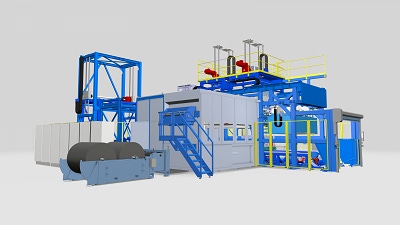Highly flexible thermoforming solution handles range of processes for vehicle interiors
German firm Frimo has developed a processing machine for deep-drawn thermoformed surfaces that can also produce in-mold graining finishes and apply laminates.
January 4, 2018

Increasingly shorter model cycles, a growing number of vehicle models, and a variety of manufacturing processes call for universally applicable production systems to be used according to German processing machinery company Frimo. In order to meet these high demands, the firm developed a combined system that can handle a range of production processes.
|
Thermoforming unit for deep-drawn thermoformed surfaces that can also produce in-mold graining finishes and apply laminates.
|
EcoCut punching machine is for trimming large and highly complex plastic components, such as instrument panels, door panels and armrests. |
|
As a result, the forming of deep-drawn surfaces, also in in-mold graining (IMG) quality, the traditional laminating as well as IMG laminating even for instrument panels can be achieved with only one machine. Another innovative feature is that the system can automatically create blanks in addition to unrolling standard film. The use of cutting-edge mechanical and electronic components guarantees superior component quality and reproducibility.
Bringing together a number of processes in a single system also reduces space requirements in production. Other features of the system include a newly developed carrier preheater to achieve the optimal temperature for adhesive joints as well as a high-speed sliding table that tilts for fast and ergonomically ideal assembly or component removal. Here, too, the use of a process optimizing chain rail, standard on Frimo laminating systems, leads to reduced material consumption and a more efficient process. Sliding frames at the forming station optimize component quality and also contribute to reduction of material use.
Another new feature is the fully automatic tool changing system with six adjustable positions – this can be extended as needed. Furthermore, automatic tool tempering minimizes changeover times. This means that no manual intervention is necessary and optimal tool availability is guaranteed.
Frimo also offers the EcoCut punching machine for trimming large and highly complex plastic components, such as instrument panels, door panels and armrests. This unit has been specifically designed for trimming in the ram direction, as well as many other punching directions, and is ideal for large series production thanks to its high efficiency. The product entry point is integrated directly into the lower table. The upper die is mobile and replaces the press ram.
Even though the EcoCut has already gained recognition for its compact design and low overall weight, Frimo continues further development of this successful model. For example, the height of modern manufacturing facility production areas is constantly becoming lower. The new EcoCut provides the same capabilities without the tall main cylinder that was present on previous models. In its place, two shorter cylinders are positioned on the front of the unit within the housing. With its shorter design, this punching unit is suitable for lower ceilings, and is also considerably easier to move with a forklift.
The ergonomic infeed has been modified for the EcoCut Compact to include a swiveling matrix holder. The holder, which previously swiveled forward out of the machine towards the operator, now swings downwards for loading the instrument panel. Once this is complete, the holder swivels upwards 60°. This ensures that the punching process can be primarily achieved using the main hoist of the machine (ram trimming). Consequently, the number of sliders required for other punching units is minimized.
Thanks to the new swivel unit design with its rear-mounted axis, the vertical stroke of the upper die can be reduced from 1200 mm to 300 mm. This not only reduces cycle times, but also allows the use of a smaller hydraulic pump and smaller electric motor, reducing energy consumption. Using frequency inverters on the motor drives has also improved energy savings.
In the previous model, punching waste was automatically discharged to the back as standard, and when installed in certain positions, such as close to a wall, it could be modified to discharge to the left or right. On the new EcoCut Compact, however, automatic waste discharge is possible in all three directions without requiring modification. Automated machine loading and unloading, e.g. using robots or a linear handling system is also possible, as is linking multiple machines together. Thus, several punching units can be combined, or combined with other systems such as scoring units or other follow-up processes.
About the Author(s)
You May Also Like






